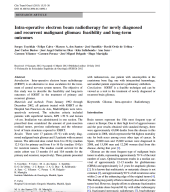OVERVIEW
Intra-operative electron beam radiotherapy (IOERT) is an alternative to dose escalation for the treatment of central nervous system tumors. The objective of this study was to describe the feasibility and long-term outcomes of IOERT in the treatment of primary and recurrent gliomas.
METHODS AND MATERIALS
From January 1992 through December 2002, all patients treated with IOERT at the Hospital San Francisco de Asis, Madrid/Spain were retrospectively reviewed. The selection criteria included patients with superficial tumors, KPS >70% and lesions <6 cm. Irradiation was administered in one section. The prescribed dose considered the amount of post-resection residual tumor, previous radiotherapy and the tolerance level of brain structures exposed to IOERT.
RESULTS
There were 17 patients (53%) with newly diagnosed malignant brain gliomas and 15 patients with recurrent tumors. The delivered dose varied from 8 to 20 Gy (median 12.5 Gy) for primary and from 8 to 16 Gy (median 10 Gy) for recurrent tumors. The median overall survival for the entire cohort was 13 months ( 14 and 10.4 months for the primary and recurrent, respectively). Three patients presented with radionecrosis one patient with osteomyelitis at craniotomy bone flap, one with intracerebral hemorrhage, and another patient experienced a pulmonary embolism.
CONCLUSION
IOERT is a feasible technique and can be viewed as a tool in the treatment of newly diagnosed or recurrent brain gliomas.
